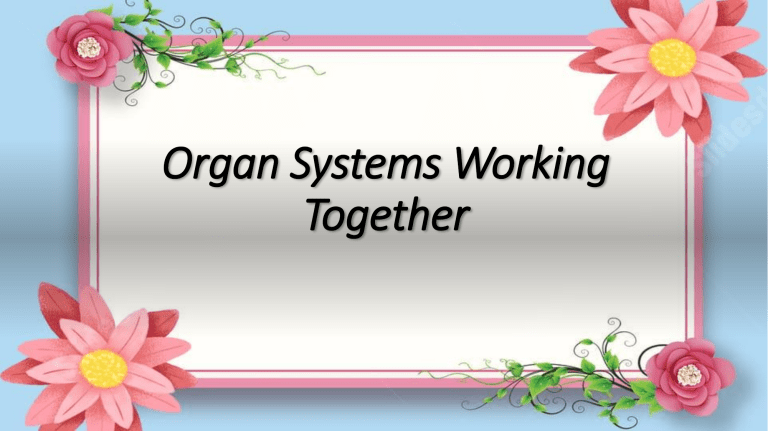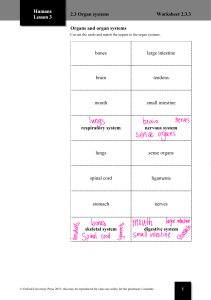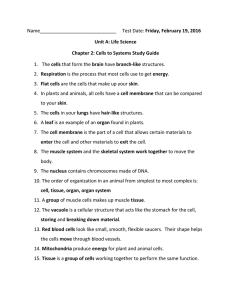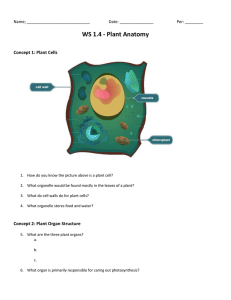
Organ Systems Working Together Four Pics, one word: Guess the word by studying how four pictures are related to each other. Write the word in the space below. Each organ system interacts with at least one other organ system. Organ systems do not work independently; organ systems interact with each other to keep our body functioning. The systems of the body are interdependent. The job that one system carries out depends on and influences jobs carried out by other systems. That’s why, you should take good care of your body so that each organ system will function properly. Each organ system interacts with at least one other organ system. Organ systems do not work independently; organ systems interact with each other to keep our body functioning. The systems of the body are interdependent. The job that one system carries out depends on and influences jobs carried out by other systems. That’s why, you should take good care of your body so that each organ system will function properly. Supply the missing words to complete the statements below. Choose your answers from the box and write them in your Science activity notebook. 1. Muscles are attached to the bones of the __________system to allow movement of the body. 2. The __________ system provides oxygen to all organ systems. 3. The __________ system depends on the circulatory system to deliver nutrients to the entire body. 4. The sense organs and the __________ system play an important role in an organism’s survival. 5. The nervous and the __________ systems interact to make body movement. Describing different types of muscles. Read the description of the following types of muscle and complete the blanks the specific types of muscles being described. ___________1. Muscles that are called involuntary these muscles cannot be controlled consciously. ___________2. Another involuntary muscle found on the walls of the heart. ___________3. Voluntary muscles that are consciously controlled to move bones. ___________4. The muscle that pumps blood throughout your body. ___________5. The muscle that found in your digestive. List down activities that you observe at home that shows the value or use of your respiratory system. Write this in your notebook. The human skeleton gives the body much-needed support, and protect the internal organs in the body. Do the following: 1. Prepare a timer. Record the time it will take you to identify the words you can search in the box. 2. Circle the words that you can find in the box Answer the following: 1. How many words did you find in the box? _______________________________ 2. How long did it take you to find the words? ________________________________________________________ ________ 3. What organ in the nervous system is used in identifying the different words? ________________________________________________________ ________ Answer the following: 1. How many words did you find in the box? _______________________________ 2. How long did it take you to find the words? ________________________________________________________ ________ 3. What organ in the nervous system is used in identifying the different words? ________________________________________________________ ________ Organ Systems Working Together Each organ system interacts with at least one other organ system. Organ systems do not work independently; organ systems interact with each other to keep our body functioning. The systems of the body are interdependent. The job that one system carries out depends on and influences jobs carried out by other systems. That’s why, you should take good care of your body so that each organ system will function properly. Match the part in Column A with its description and function in Column B. Column A _____1. Femur _____2. Tibia/Fibula _____3. Tarsals _____4. Metatarsals _____5. Vertebrae _____6. Phalanges _____7. Patella _____8. Skeletal muscle _____9. Smooth muscle _____10. Cardiac muscle Column B A. the knee bone B. two bones in the lower leg C. ankle bones D. long bone in the upper leg E. known as foot bones F. the spine or backbone G. toe bones H. muscles that attached to the bones I. muscles that found only in the heart List down activities that you observe at home that shows the value or use of your respiratory system. Write this in your notebook. The human skeleton gives the body much-needed support, and protect the internal organs in the body. Identify which organ systems are working together in the activities shown in the pictures below. Write the letter of your answer in your Science activity notebook. Identify which organ systems are working together in the activities shown in the pictures below. Write the letter of your answer in your Science activity notebook. Identify which organ systems are working together in the activities shown in the pictures below. Write the letter of your answer in your Science activity notebook. Organ Systems Working Together Have you observed how houses are built? Houses and buildings are not just wood, concrete, bricks and stone. Man put frames like steel or wood in buildings to make them stronger and flexible. Framing is an early stage of building a house. The framework in houses is similar with the skeletal system. The skeletal system provides the structural framework for the body and protects internal organs such as heart, lungs and brain. • Musculoskeletal system: Consists of the skeletal system –bones and joints and the skeletal muscle system. • Respiratory system takes in oxygen from the air. It also gets rid of carbon dioxide Organisms exchanges gases with the environment in the process called respiration. Respiration includes the intake of oxygen and its delivery to the cells of the different parts of the body and the removal and release of carbon dioxide. Breathing is very vital in life • Digestive system absorbs water and nutrients from the food you eat. Biting is the first step in breaking down food. As you chew, the salivary gland makes saliva that carried through tiny tubes to your mouth to make your food wet and easy to swallow. • Circulatory system carries oxygen, water, and nutrients to cells throughout your body. The circulatory system works together with the digestive system in transporting nutrients and minerals to all parts of the body. • Integumentary system reduces water loss, contains receptors that respond to touch, regulates body temperature, and protects the inside of the body from damage. Receptors in skin send sensory information to the brain. • Nervous system regulates peripheral blood flow and sweat glands. It regulates activities that are automatic or voluntary. The autonomic nervous system controls muscles in the heart and the smooth muscles in internal organs such as intestine, bladder and uterus Fill in the missing letters of fruits and vegetables to reveal the magic word. Match the bone with the major function. There may be more than one function to certain bones Write the letter of the correct answer on the blank. You have already known the different combination of materials. You are also familiar with the appearance of solid and solid, solid and liquid and liquid and liquid. What precautionary measures should you observe when using and storing different materials at home? Healthful habits that promote proper functioning of all the organs systems in the body. 1. Exercise regularly 2. Eat a well-balanced and low-fat-diet 3. Live in a clean environment 4. Avoid smoking cigarette or staying with smokers 5. Have a positive outlook in life Fill –in the blanks: Choose the word of the correct answer on the box below. Write your answer on your answer sheet _________1. The system that carries oxygen, water, and nutrients to cells throughout your body _________2. It regulates activities that are automatic or voluntary. _________3. It absorbs water and nutrients from the food you eat _________4. It takes in oxygen from the air and also gets rid of carbon dioxide _________5. The system that comprises the skin and its appendages acting to protect the body from various kinds of damage. Fill –in the blanks: Choose the word of the correct answer on the box below. Write your answer on your answer sheet _________1. The system that carries oxygen, water, and nutrients to cells throughout your body _________2. It regulates activities that are automatic or voluntary. _________3. It absorbs water and nutrients from the food you eat _________4. It takes in oxygen from the air and also gets rid of carbon dioxide _________5. The system that comprises the skin and its appendages acting to protect the body from various kinds of damage. Organ Systems Working Together Have you observed how houses are built? Houses and buildings are not just wood, concrete, bricks and stone. Man put frames like steel or wood in buildings to make them stronger and flexible. Framing is an early stage of building a house. The framework in houses is similar with the skeletal system. The skeletal system provides the structural framework for the body and protects internal organs such as heart, lungs and brain. • Musculoskeletal system: Consists of the skeletal system –bones and joints and the skeletal muscle system. • Respiratory system takes in oxygen from the air. It also gets rid of carbon dioxide Organisms exchanges gases with the environment in the process called respiration. Respiration includes the intake of oxygen and its delivery to the cells of the different parts of the body and the removal and release of carbon dioxide. Breathing is very vital in life • Digestive system absorbs water and nutrients from the food you eat. Biting is the first step in breaking down food. As you chew, the salivary gland makes saliva that carried through tiny tubes to your mouth to make your food wet and easy to swallow. • Circulatory system carries oxygen, water, and nutrients to cells throughout your body. The circulatory system works together with the digestive system in transporting nutrients and minerals to all parts of the body. • Integumentary system reduces water loss, contains receptors that respond to touch, regulates body temperature, and protects the inside of the body from damage. Receptors in skin send sensory information to the brain. • Nervous system regulates peripheral blood flow and sweat glands. It regulates activities that are automatic or voluntary. The autonomic nervous system controls muscles in the heart and the smooth muscles in internal organs such as intestine, bladder and uterus Match the parts of Musculo-Skeletal System in column A with its description and functions in column B You have already known the different combination of materials. You are also familiar with the appearance of solid and solid, solid and liquid and liquid and liquid. What precautionary measures should you observe when using and storing different materials at home? Healthful habits that promote proper functioning of all the organs systems in the body. 1. Exercise regularly 2. Eat a well-balanced and low-fat-diet 3. Live in a clean environment 4. Avoid smoking cigarette or staying with smokers 5. Have a positive outlook in life Answer the questions by writing True or False. If it is false, replace the underlined word with the correct word to make the statement correct. __________1. The nervous system is the control system of the body. ___________ 2. The nerve cells is the basic unit of the nervous system. ___________ 3. The brain is found all over your body . ___________ 4. The brain has three main parts : cerebrum , cerebellum and the medulla oblongata






